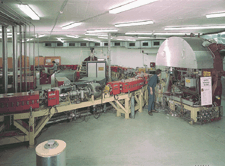Nature 401, 6 (1999) © Macmillan Publishers Ltd.
Heather McCabe
[PARIS] Scientists will tour the Middle East this month to drum up support for a planned synchrotron facility, which is threatened by lack of funding.
Sesame seed: BerlinÕs Bessy-1 could create a new facility in the Middle East.
The Sesame (Synchrotron radiation for Experimental Science and Applications in the Middle East) project would involve moving and upgrading Bessy-1, a decommissioned 0.8 GeV synchrotron radiation source in Berlin. But it must be dismantled and packed by the end of this year. That alone is expected to cost half a million dollars.
Maurizio Iaccarino, United Nations Educational, Scientific and Cultural Organization (Unesco) assistant director-general for natural sciences, and Herwig Schopper, former director-general of the European Laboratory for Particle Physics (CERN) and president of the project's interim council, are to visit several countries that have shown an interest in the project.
Because the facility would be open to scientists of any nationality, organizers see its potential as not only a world-class research centre, but also as a politically important example of scientific cooperation in the region.

"A project costing US$50 million over ten years needs a strong political commitment," says Siegbert Raither, director of mathematics, physical and chemical sciences at Unesco.
Egypt, Iran, the Palestinian Authority and Armenia have all made official bids to host the centre, and several other countries in the region are supportive. But they are not expected to be able to finance the venture themselves, so organizers need to seek financial aid from the European Union countries and the United States.
Heather McCabe
 Nature Macmillan Publishers Ltd 1999 Registered No. 785998 England.
Nature Macmillan Publishers Ltd 1999 Registered No. 785998 England.

